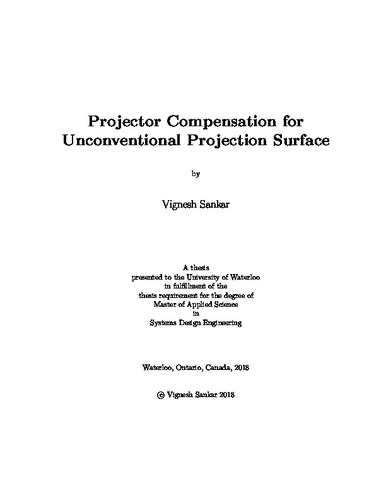| dc.contributor.author | Sankar, Vignesh | |
| dc.date.accessioned | 2018-12-19 15:01:12 (GMT) | |
| dc.date.available | 2018-12-19 15:01:12 (GMT) | |
| dc.date.issued | 2018-12-19 | |
| dc.date.submitted | 2018-12-12 | |
| dc.identifier.uri | http://hdl.handle.net/10012/14261 | |
| dc.description.abstract | Projecting onto irregular textured surfaces found on buildings, automobiles and theatre stages calls for the development of radiometric and geometric compensation algorithms that require no user intervention and compensate for the patterning and colourization of the background surface. This process needs a projector-camera setup where the feedback from the camera is used to learn the background's geometric and radiometric properties. In this thesis, radiometric compensation, which is used to correct for the background texture distortion, is discussed in detail. Existing compensation frameworks assume no inter--pixel coupling and develop an independent compensation model for each projector pixel. This assumption is valid on background with uniform texture variation but fails at sharp contrast differences leading to visible edge artifacts in the compensated image.
To overcome the edge artifacts, a novel radiometric compensation approach is presented that directly learns the compensation model, rather than inverting a learned forward model. That is, the proposed method uses spatially uniform camera images to learn the projector images that successfully hide the background. The proposed approach can be used with any existing radiometric compensation algorithm to improve its performance. Comparisons with classical and state-of-the-art methods show the superiority of the proposed method in terms of the perceived image quality and computational complexity.
The modified target image from the radiometric compensation algorithm can exceed the limited dynamic range of the projector resulting in saturation artifacts in the compensated image. Since the achievable range of luminance on the background surface with the given projector is limited, the projector compensation should also consider the contents of the target image along with the background properties while calculating the projector image. A novel spatially optimized luminance modification approach is proposed using human visual system properties to reduce the saturation artifacts. Here, the tolerance of the human visual system is exploited to make perceptually less sensitive modifications to the target image that in turn reduces the luminance demands from the projector. The proposed spatial modification approach can be combined with any radiometric compensation models to improve its performance. The simulated results of the proposed luminance modification are evaluated to show the improvement in perceptual performance. The inverse approach combined with the spatial luminance modification concludes the proposed projector compensation, which enables the optimum compensated projection on an arbitrary background surface. | en |
| dc.language.iso | en | en |
| dc.publisher | University of Waterloo | en |
| dc.subject | Projector Technology | en |
| dc.subject | Radiometric Compensation | en |
| dc.title | Projector Compensation for Unconventional Projection Surface | en |
| dc.type | Master Thesis | en |
| dc.pending | false | |
| uws-etd.degree.department | Systems Design Engineering | en |
| uws-etd.degree.discipline | System Design Engineering | en |
| uws-etd.degree.grantor | University of Waterloo | en |
| uws-etd.degree | Master of Applied Science | en |
| uws.contributor.advisor | Fieguth, Paul | |
| uws.contributor.advisor | Clausi, David | |
| uws.contributor.affiliation1 | Faculty of Engineering | en |
| uws.published.city | Waterloo | en |
| uws.published.country | Canada | en |
| uws.published.province | Ontario | en |
| uws.typeOfResource | Text | en |
| uws.peerReviewStatus | Unreviewed | en |
| uws.scholarLevel | Graduate | en |

